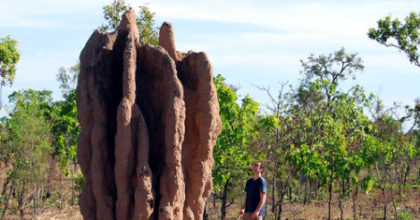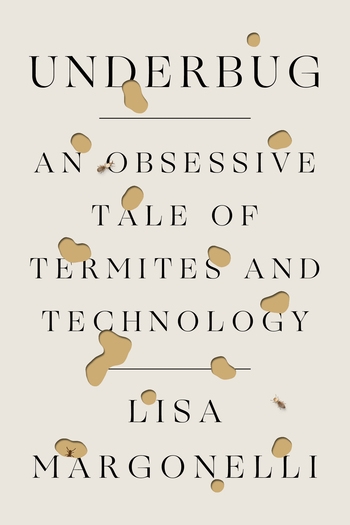
 )
)I know the maxim, but you have to respect the aesthetic of cutting holes out of the dust jacket for a book about termites. I’m game for learning about termite biology anyway, and that attention to detail in the presentation of Lisa Margonelli’s Underbug: An Obsessive Tale of Termites and Technology sealed the deal. Imagine my surprise, then, when the book was not as much about termites as I was hoping. Termites feature prominently, but it’s one of those “it was really about us all along” kind of stories. I suspect many of you will be just as happy to read Margonelli’s thoughtful commentary on our relationship to technology and its role in the projection of power. Silly me though; I was here for the entomology.
Somewhere in the first few chapters it dawned on me that while I’ve read my share of science books, I have tended to read the ones by scientists. I never explicitly decided on such a plan in those terms. I do gravitate towards books by authors I recognize; that like introduced the bias toward scientists. So I’ve gotten used to a certain kind of writing about science. Lisa Margonelli is an accomplished journalist and skilled writer and definitely has a journalist’s perspective. She is interested in human details and narratives, writing at length about how scientists practice their craft rather than just reporting on what they find. Covering termites seems to be her first exposure to the practice of biology, given her fascination with some of the most mundane details. The paragraph on gel electrophoresis equipment, down to the color scheme, was perhaps the most remarkable combination of meticulous detail and obvious omission; the colors are only interesting if you include the mnemonic about running to the red. There may very well be an audience who wants to learn what a day in a molecular biology lab or a termite dig is like. To me, it felt like reading the methods section of a paper that didn’t have results.
To be fair, there are some details about termites and related biology. I was especially excited by the discussion of Mixotricha paradoxa, a protozoan which lives in the gut of an Australian termite species and which itself has four distinct bacterial symbionts. More mind-bending microbiology, please. Yet in many ways a lack of results is one of the stories of Underburg; Margonelli is deliberately painting a picture of science which is not linear or neatly progressive, where everything that looks like an answer is really three new questions. The feeling that there should be more substance is at least partly a feature, not a bug.

Many of the scientists she profiles and Margonelli herself were drawn to termites because of the potential for commercial exploitation. First we learn about research teams who hope termites hold the key to renewable energy sources. Termites are rare among organisms for their ability to digest cellulose and other complex molecules that give plants their structure. You and I cannot use wood as food, but termites can. Or rather, the unique microbes living in the guts of termites can. So all we need to do is find which specific microbe, or even better which specific gene, manages this trick and we can harness it to make fuel from wood. Sounds simple, but it might be too simple. It looks like there isn’t a single microbe, let alone an enzyme; we may actually need the entire termite gut ecosystem.
A second research community is interested in termites for their behavior, not their biochemistry. Termite colonies pull off some impressive feats of architecture and agriculture. No single termite seems capable of knowing how to build a termite mound, yet termite mounds are plentiful. We believe those mounds arise from the application of simple, termite-scale rules or behaviors. If we could learn those rules, we might be able to get swarms of small robots to manage sophisticated tasks. Here again, typical reductionist approaches don’t seem to be working. Studying small groups of termites in strictly controlled conditions has not yielded many answers about how mounds are constructed. The robots they inspired haven’t fully realized their promise either.
Margonelli does not seem overly upset about either development, or lack thereof. She cites previous inventions of nitrogen fertilizer and military technology like machine guns and chemical warfare as examples of technology with profound unintended consequences. Maybe we’re better off without termite technology magnified to human scale. I’m not sure I’m as pessimistic as Margonelli, but I see where she’s coming from.
Andy has worn many hats in his life. He knows this is a dreadfully clichéd notion, but since it is also literally true he uses it anyway. Among his current metaphorical hats: husband of one wife, father of two teenagers, reader of science fiction and science fact, enthusiast of contemporary symphonic music, and chief science officer. Previous metaphorical hats include: comp bio postdoc, molecular biology grad student, InterVarsity chapter president (that one came with a literal hat), music store clerk, house painter, and mosquito trapper. Among his more unique literal hats: British bobby, captain’s hats (of varying levels of authenticity) of several specific vessels, a deerstalker from 221B Baker St, and a railroad engineer’s cap. His monthly Science in Review is drawn from his weekly Science Corner posts — Wednesdays, 8am (Eastern) on the Emerging Scholars Network Blog. His book Faith across the Multiverse is available from Hendrickson.

Leave a Reply